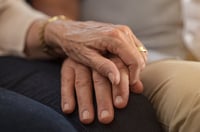Women who have endometriosis have a higher risk of mental illnesses such as depression, anxiety,...
ECT May Reduce Risk of Death in Older Patients Hospitalized for Psychiatric Disorders

Patients aged 65 or older who received electroconvulsive therapy (ECT) while hospitalized for a psychiatric disorder were found to have a lower rate of death in the year following discharge than similar patients who did not receive ECT while hospitalized, reports a study in AJP in Advance.
“This report adds to a growing body of research suggesting a positive effect of ECT from a population health perspective,” wrote Taeho Greg Rhee, Ph.D., of the University of Connecticut and colleagues. “Future efforts should focus on ways to ensure broader implementation of this treatment and to improve the maintenance therapy of severely ill patients who receive ECT.”
In this observational study, Rhee and colleagues used Medicare claims data to compare the mortality of Medicare beneficiaries 65 and up who received at least one ECT session during a psychiatric hospitalization between 2011 and 2015 with those who did not receive ECT during a psychiatric hospitalization. The final sample included 10,460 ECT patients and 31,160 control patients who were matched based on such characteristics as age, gender, and number of psychiatric hospitalizations in the previous year. The authors compared the mortality rates of patients due to various causes at one, two, three, six, and 12 months after their discharge from the hospital.
Patients who received at least one ECT session had a 39% lower rate of all-cause mortality 12 months after discharge compared with patients who did not receive ECT, while patients who received at least five sessions of ECT within a 30-day period had a 44% lower all-cause mortality rate.
In looking at different mortality categories, the authors found that ECT patients were less likely to die from smoking-related diseases, circulatory diseases, diabetes, and cancer. “While several mechanisms may be at play, one potential way in which ECT might lead to reduction in mortality risk is that improved functioning following ECT allows patients to maintain a healthier lifestyle and to better engage in treatment for whatever medical conditions they face,” they wrote.
Older patients who received any ECT or at least five sessions of ECT also had a 44% and 59% lower rate of suicide after three months, respectively, compared with patients who received no ECT, but by one year suicide rates of both groups were similar. “This is in line with the traditional understanding of the treatment course of ECT, where a large portion of ECT patients relapse after 6 months without a continuation treatment,” the authors wrote.
To read more on this topic, see the Psychiatric News article “When Is ECT Right for Your Patients With Depression?”
(Image: iStock/Ridofranz)
Today at 3 p.m. ET: Ask an App Advisor
Join APA’s App Advisor Expert Panel today, September 14, as they field your questions about APA’s App Evaluation Model. Registrants are encouraged to pre-submit their questions using the Zoom registration page.





